
Inadequacies of language—whether legal, symbolic, written or visual—are cast into stark relief during moments of social upheaval. Associations once normalized by cultural hegemonies are opened up into sites of contention. Canons, monuments and institutional mandates are called into question, histories reassessed, and so too are visual codes that derive from those histories. Within this condition of restlessness, artists continue to revise, reshape, adapt and recondition existing cultural forms by breaking them down to their structural foundations or rehabilitating semantic objects in states of entropy. Employing a diverse range of media and underlying intentions, the work of the six artists presented in Restless Index represents a vision within a specific bandwidth of this paradigm drawing on language, figures, monuments and architecture.

As an introduction to the exhibition, Larry Johnson’s Paul Rand’s Women, 1948 (1984) captures and restructures the graphic design of a book-cover by Paul Rand, perverting the static composition into a playful animation that uses camp as a means to unrest the hegemony of language. In the film, letters dance off the word M-E to M-E-N, O-M-E-N, and finally the titular arrangement W-O-M-E-N. Withholding finality on any single term, the animated gesture gives substance to the process of interpretation and a fluid motion of syntax in relation to thought, body and presence.
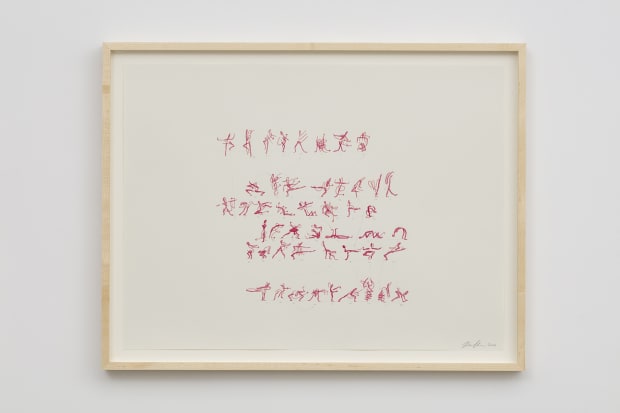
In a converse relationship between body and text, individual and collective, the diagrams of figurative gestures captured in Madeline Hollander’s drawings document body movement into glyphs that are further re-interpreted into choreography works. This new suite of drawings, scoring the movements of dancers in the process of rehearsing, specifically notate her upcoming performance Preview. These notations highlight ballet’s ubiquitous hand-language, called "marking," which is used globally as a gestural form for communicating dance movements and as a way to practice choreography while conserving energy.
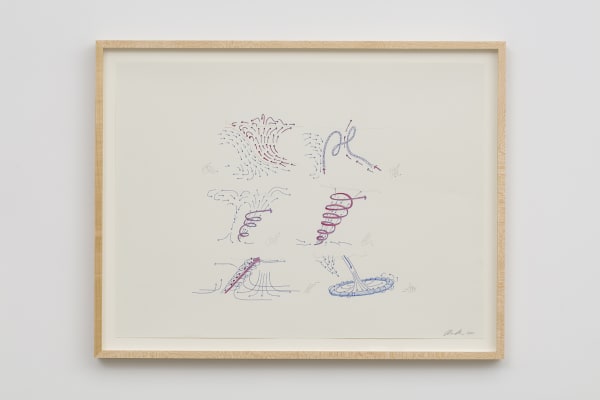
MADELINE HOLLANDER
Derecho, Supercell, Squall Sequence (Preview)
2020
Watercolor, ink, graphite, and colored pencil on archival paper
18 x 24 inches; 45.7 x 61 cm (unframed)
21 1/2 x 26 9/16 x 1 1/2 inches; 54.6 x 67.5 x 3.8 cm (framed)

MADELINE HOLLANDER
Perpetual Sextet (Preview)
2020
Watercolor, Ink, colored pencil on archival paper
18 x 24 inches; 45.7 x 61 cm (unframed)
21 1/2 x 26 9/16 x 1 1/2 inches; 54.6 x 67.5 x 3.8 cm (framed)

MADELINE HOLLANDER
Sea Birds Marking Sequence (Preview)
2020
Watercolor, ink, graphite, and colored pencil on archival paper
18 x 24 inches; 45.7 x 61 cm (unframed)
21 1/2 x 26 9/16 x 1 1/2 inches; 54.6 x 67.5 x 3.8 cm (framed)

MADELINE HOLLANDER
Sea Star Countdown Sequence (Preview)
2020
Watercolor, Ink, colored pencil on archival paper
18 x 24 inches; 45.7 x 61 cm (unframed)
21 1/2 x 26 9/16 x 1 1/2 inches; 54.6 x 67.5 x 3.8 cm (framed)
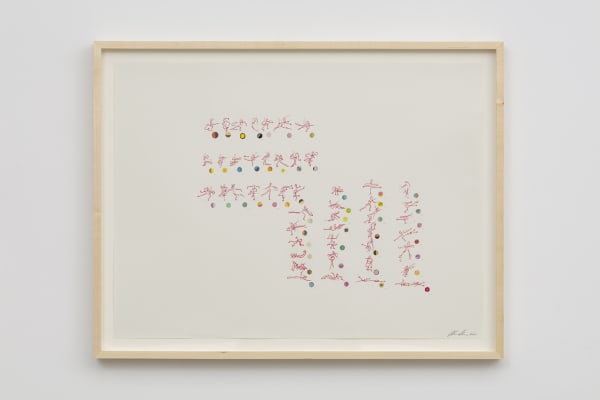
MADELINE HOLLANDER
Siren vs Firebird (Preview)
2020
Watercolor, ink, graphite, and colored pencil on archival paper
18 x 24 inches; 45.7 x 61 cm (unframed)
21 1/2 x 26 9/16 x 1 1/2 inches; 54.6 x 67.5 x 3.8 cm (framed)
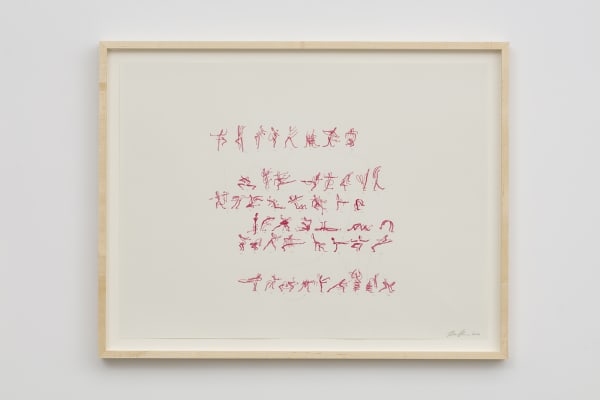
MADELINE HOLLANDER
Steps 1 - 48 (Preview)
2020
Watercolor, Ink, colored pencil, and graphite on archival paper
18 x 24 inches; 45.7 x 61 cm (unframed)
21 1/2 x 26 9/16 x 1 1/2 inches; 54.6 x 67.5 x 3.8 cm (framed)

Hollander’s glyphic figures gaze out into the ‘plaza’ of the exhibition where human residue is inscribed into floor works by Michael Queenland. Collected on the artist’s recurring dérives through Rome, the detritus—advertisement cards, lottery tickets, notes and paper fragments—were scanned and printed to scale onto ceramic tiles. The works operate outside of the past, present, or future, asking what evidence these objects hold in regard to their original and newfound sense of place between archive and ruin. Clippings from the New York Times displayed elsewhere in the exhibition evidence sited and cited time in relation to physicality and mortality. Each image is reexamined in its new context — recto to verso — hinged between death and posterity.

Michael Queenland
Untitled (Services #2)
2017
Marble, granite, ceramic tile, dye sublimation tile, wood, and metal frame
64 1/4 x 32 1/4 x 1 inches; 163.2 x 81.9 x 2.5 cm
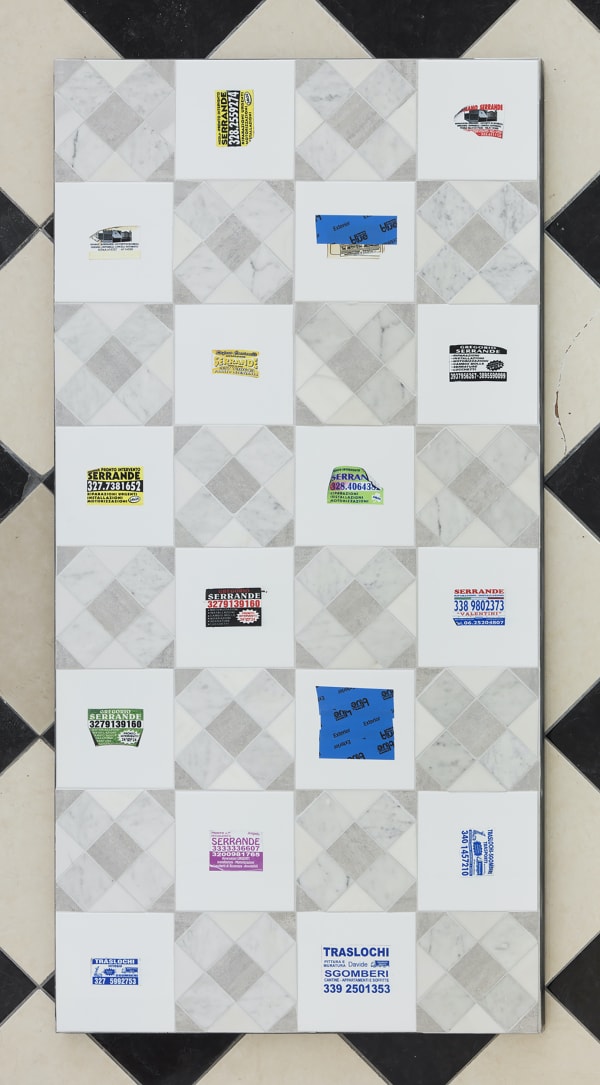
Michael Queenland
Untitled (Services #3)
2017
Marble, granite, ceramic tile, dye sublimation tile, wood, tape, and metal frame
64 1/4 x 32 1/4 x 1 inches; 163.2 x 81.9 x 2.5 cm

Michael Queenland
Untitled (Stationary)
2017
Marble, granite, ceramic tile, dye sublimation tile, wood, and metal frame
32 1/4 x 32 1/4 x 3 inches; 81.9 x 81.9 x 7.6 cm

Michael Queenland
Untitled (New York Times, June 8, 2012)
2012
Archival inkjet print
14 1/2 x 11 1/2 inches; 36.8 x 29.2 cm (framed)
Edition of 2
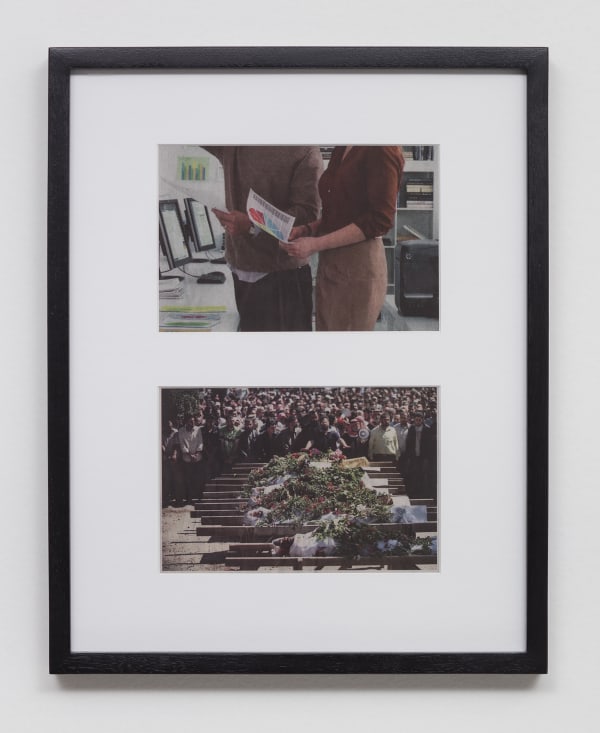
MICHAEL QUEENLAND
Untitled (New York Times, June 18, 2012)
2012
Archival inkjet print
14 1/2 x 11 1/2 inches; 36.8 x 29.2 cm (framed)
Edition of 2


Overlooking Queenland’s contemporary Romanesque is a void of space delineating a neoclassical monument. In Fallen Rider, 1792 (2019) by Sean Townley, a matrix of plumb bobs hang from an aluminum frame. Based on an ancient device for sculptural reproduction, its hundreds of points index the form of a missing monument—a sculpted equestrian by François Girardon of Louis XIV as a victorious Roman emperor. Despised for its representation of monarchical absolutism, it was ultimately destroyed during the French Revolution in 1792. Rendered in negative space, Fallen Rider, 1792 continues Townley’s research into the changing and overlapping narratives of classical sculpture, impacted by figurative and literal cycles of erosion and revision.

Sean Townley
Fallen Rider (1792)
2020
Laser cut and acid etched aluminum, zinc, lead, steel cable and hardware
120 x 91 x 51 inches; 304.8 x 231.1 x 129.5 cm

Opposite the exiled rider, Lisa Williamson’s Body Board (Landscape) (2020) offers a reduced representation of space on a dichromatic field of green. Extrusions projecting off the surface further disrupt pictorial depth, prompting a restless classification between painting and relief. Williamson's Door (2014) consists of a frame and a void, its only signifier in its title. Mirroring this symbol, the physical doorway in the gallery space leads to a room divided by two long cylinders by the artist titled Poems (2020). Chromatic divisions on these works suggest an unspecified internal logic. Core samples and measuring devices come to mind, yet the title also alludes to linguistic structure as if lines of poetry were synthetically manifested into solid form.
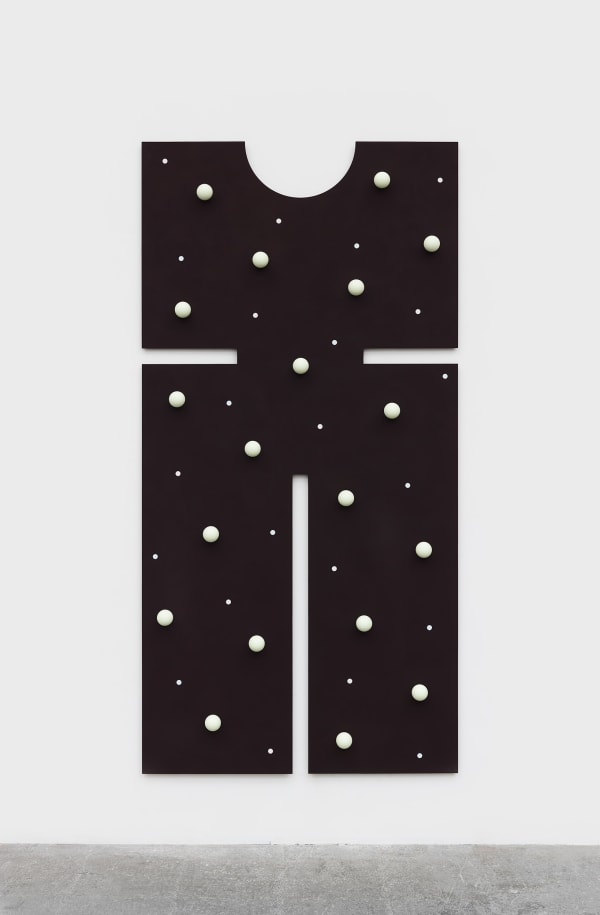
Lisa Williamson
Body Board (Constellation)
2019
Acrylic, flashe, microbeads on powder-coat primed aluminum
80 x 40 x 2 1/2 inches; 203.2 x 101.6 x 6.4 cm
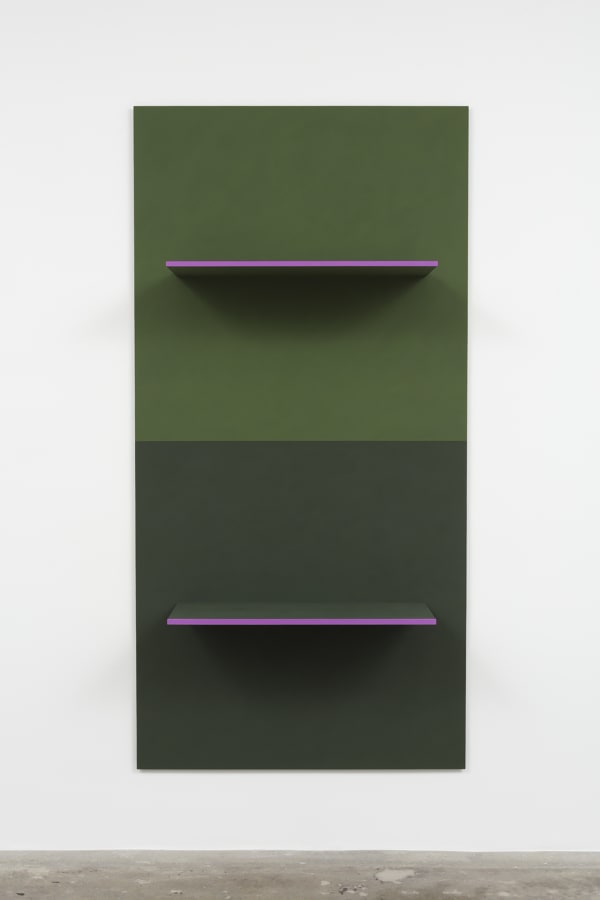
LISA WILLIAMSON
Body Board (Landscape)
2020
Flashe, microbeads on powder-coat primed aluminum
80 x 40 x 12 3/4 inches; 203.2 x 101.6 x 32.4cm

Lisa Williamson
Door
2014
Acrylic on powder-coat primed aluminum
84 x 24 x 1 inches; 213.4 x 61 x 2.5 cm
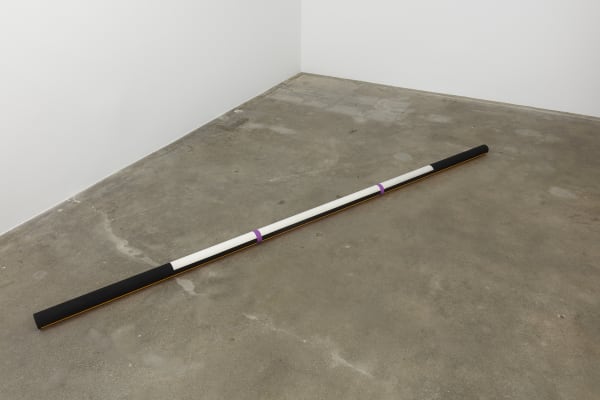
LISA WILLIAMSON
Poem (Nest)
2020
Acrylic, flashe, microbeads on powder-coat primed aluminum
132 x 3 x 3 inches; 335.3 x 7.6 x 7.6 cm

LISA WILLIAMSON
Poem (Quattro & Gren)
2020
Acrylic, flashe, microbeads on powder-coat primed aluminum
132 x 3 x 3 inches; 335.3 x 7.6 x 7.6 cm


Following the line and language of redirection, Analia Saban’s Magnetic Core Memory Structure #5 (2020) uses a fine thread of acrylic paint to weave through individual fibers of linen. With a broad warp and weft defined by regular notches in the walnut stretcher bars, the work creates rhythmic passages, reevaluating the roles of traditional painting materials. In this composition the defining structure is time and memory, yet revealed within this economy of gesture is a material truth that governs the medium. The delicate open mesh evokes the copper wire thread pattern of historical Magnetic-core memory chips as well as the permeable surface of a painted canvas under magnification, referencing the origins of computer memory while recording the construction of painting.
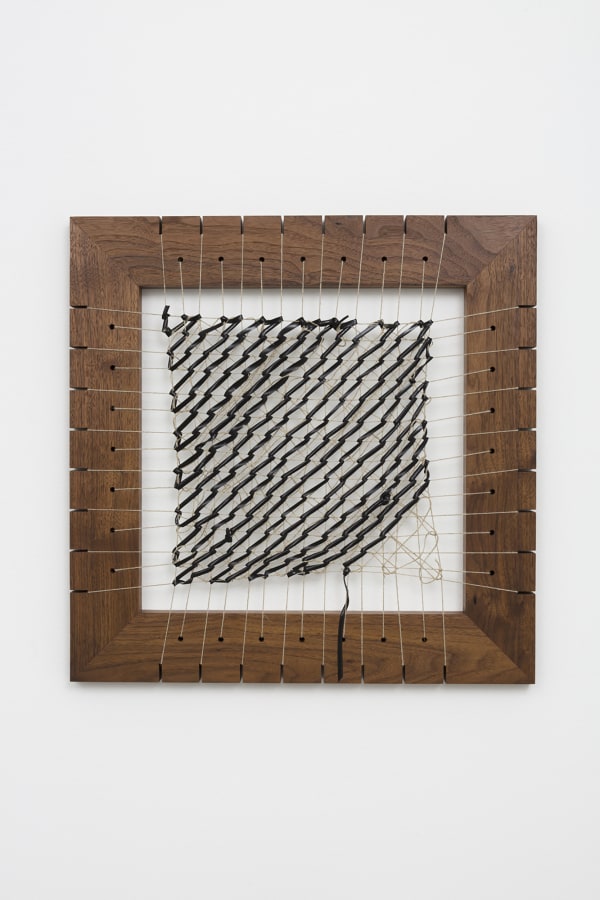
Analia Saban
Magnetic Core Memory Structure #5
2020
Woven acrylic paint through linen thread on walnut
23 x 23 inches; 58.4 x 58.4 cm

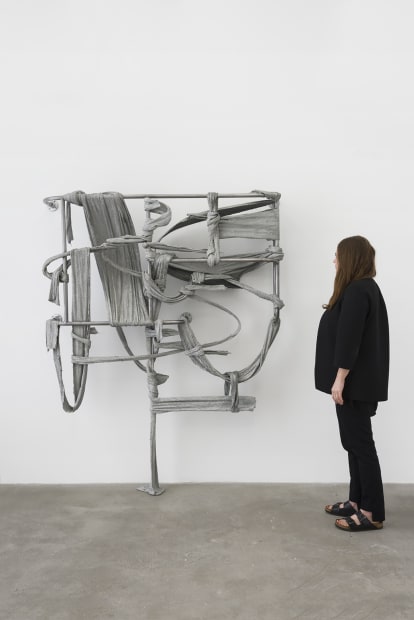
At the opposite end of the exhibition Nikita Gale’s work, displayed alongside Queenland’s shrouded figures, engages a very different type of weaving. Wrapped in a nest of concrete-dipped rags that congeal onto the floor, a structure of bent and welded steel tubing implying an ergonomic function is rendered useless. Drawing on the ambient presence of infrastructural materials like concrete and steel and their use in facilitating or obstructing social action, the work’s surface conveys the dull flat resonance of institutionalism or an improvised brutalism. Yet these references, while valuable to consider, are kept at a strategic distance where referent is shaken loose, tattered and knotted into a new condition, with new meaning.

Nikita Gale
RUINER I
2020
Steel, towel, concrete
78 x 60 x 14 inches; 198 x 152.4 x 36 cm